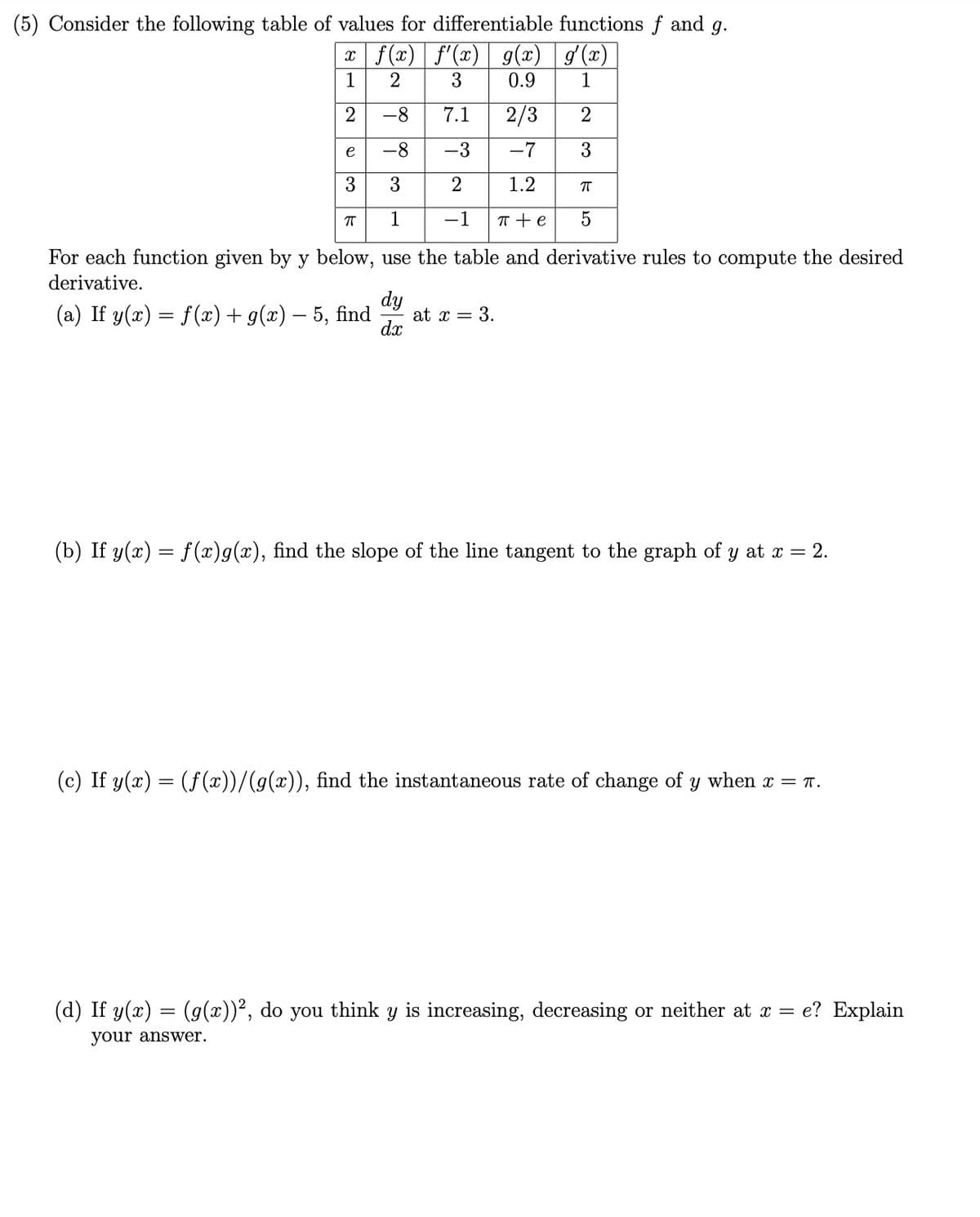(5) Consider the following table of values for differentiable functions f and g. xf(x) f'(x)| g(x) | g(x) 1 2 3 0.9 1 -8 7.1 2/3 2 e -8 -3 -7 3 3 2 1.2 1 -1 T +e For each function given by y below, use the table and derivative rules to compute the desired derivative. dy at x = 3. dx (a) If y(x) = f(x) + g(x) – 5, find (b) If y(x) = f(x)g(x), find the slope of the line tangent to the graph of y at x = 2. (c) If y(x) = (f (x))/(g(x)), find the instantaneous rate of change of y when x = T. (d) If y(x) = (g(x))², do you think is increasing, decreasing or neither at x = e? Explain your answer.
(5) Consider the following table of values for differentiable functions f and g. xf(x) f'(x)| g(x) | g(x) 1 2 3 0.9 1 -8 7.1 2/3 2 e -8 -3 -7 3 3 2 1.2 1 -1 T +e For each function given by y below, use the table and derivative rules to compute the desired derivative. dy at x = 3. dx (a) If y(x) = f(x) + g(x) – 5, find (b) If y(x) = f(x)g(x), find the slope of the line tangent to the graph of y at x = 2. (c) If y(x) = (f (x))/(g(x)), find the instantaneous rate of change of y when x = T. (d) If y(x) = (g(x))², do you think is increasing, decreasing or neither at x = e? Explain your answer.
Calculus: Early Transcendentals
8th Edition
ISBN:9781285741550
Author:James Stewart
Publisher:James Stewart
Chapter1: Functions And Models
Section: Chapter Questions
Problem 1RCC: (a) What is a function? What are its domain and range? (b) What is the graph of a function? (c) How...
Related questions
Question
I need help answering all parts of question #5. Please make sure to really explain and show steps so I understand how to do it.

Transcribed Image Text:(5) Consider the following table of values for differentiable functions f and
g.
x f(x) f'(x) g(x) g(x)
1
2
0.9
1
2
-8
7.1
2/3
2
e
-8
-3
-7
3
3
1.2
1
-1
TT +e
For each function given by y below, use the table and derivative rules to compute the desired
derivative.
(a) If y(x) = f(x)+ g(x) – 5, find
dy
at x = 3.
dx
(b) If y(x) = f(x)g(x), find the slope of the line tangent to the graph of y at x = 2.
(c) If y(x) = (f (x))/(g(x)), find the instantaneous rate of change of y when x = T.
(d) If y(x) = (g(x))², do you think y is increasing, decreasing or neither at x = e? Explain
your answer.
Expert Solution
Step 1
Trending now
This is a popular solution!
Step by step
Solved in 3 steps

Knowledge Booster
Learn more about
Need a deep-dive on the concept behind this application? Look no further. Learn more about this topic, calculus and related others by exploring similar questions and additional content below.Recommended textbooks for you

Calculus: Early Transcendentals
Calculus
ISBN:
9781285741550
Author:
James Stewart
Publisher:
Cengage Learning

Thomas' Calculus (14th Edition)
Calculus
ISBN:
9780134438986
Author:
Joel R. Hass, Christopher E. Heil, Maurice D. Weir
Publisher:
PEARSON

Calculus: Early Transcendentals (3rd Edition)
Calculus
ISBN:
9780134763644
Author:
William L. Briggs, Lyle Cochran, Bernard Gillett, Eric Schulz
Publisher:
PEARSON

Calculus: Early Transcendentals
Calculus
ISBN:
9781285741550
Author:
James Stewart
Publisher:
Cengage Learning

Thomas' Calculus (14th Edition)
Calculus
ISBN:
9780134438986
Author:
Joel R. Hass, Christopher E. Heil, Maurice D. Weir
Publisher:
PEARSON

Calculus: Early Transcendentals (3rd Edition)
Calculus
ISBN:
9780134763644
Author:
William L. Briggs, Lyle Cochran, Bernard Gillett, Eric Schulz
Publisher:
PEARSON

Calculus: Early Transcendentals
Calculus
ISBN:
9781319050740
Author:
Jon Rogawski, Colin Adams, Robert Franzosa
Publisher:
W. H. Freeman


Calculus: Early Transcendental Functions
Calculus
ISBN:
9781337552516
Author:
Ron Larson, Bruce H. Edwards
Publisher:
Cengage Learning